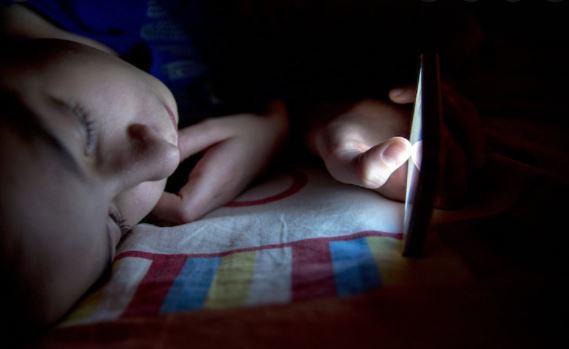Sleep and technology: achieving better sleep health for our kids

The purpose here is to explore what impact evening media use has on our students’ schoolwork and/or sufficient healthy sleep. Does it compromise students’ ability or aptitude for positive academic success?
Technology is increasingly relied on by modern society. Parents, kids, and teachers alike all
use technology for work and during downtime. Researchers from the US estimated that the average
young person spends 7.7 hours on handheld screens each day (Nagata et al., 2020). With these technologies only relatively new, research is looking to better understand how these behaviours impact our lives and the importance of establishing some healthy guidelines.
The Research
Studies have linked technology use with poorer diet, fitness and mood. Additionally, technology has been hypothesised to have an impact on young people’s sleep in particular. Recent studies have shown that students who use technology achieve less total sleep time than students with stricter lights out policies (Bartel et al., 2019). As such, technology is increasingly a topic of discussion for everyone —adolescents, educators, parents, and researchers.
While technology is often portrayed negatively by the media, there are many ways
that technology is being used positively! Our literacy programs co-join the four elements of literacy learning (comprehension, spelling, grammar and punctuation) with technology. We see the benefits of technology to engage and motivate students to improve their reading skills.
Additionally, tech can be a great medium to connect: texting with family, video calls with grandparents, and social media to stay up-to date with friends. These activities are all valuable ways to improve students’ important connections with others. Many apps such as Smiling Mind , which is a non-for-profit web and app-based meditation program developed by psychologists and educators, helps to bring mindfulness and wellbeing into the life of young people.
Screen time is linked to a host of insomnia symptoms in pre-teens and teenagers. Let’s look at 3 impacts:
1. Melatonin
Each evening, our body produces melatonin. This hormone allows us to feel drowsy, assisting us to
fall asleep. By delaying the release of melatonin, screen time pushes back bedtime and leads to less restful sleep.
2. Exciting and Emotive Content
Engaging in exciting or violent content before bedtime, or using social media, can boost alertness and impede sleepiness. Texting with friends, playing video games and scrolling through social media can be stimulating, exciting and emotional.
Alertness and melatonin levels can also be affected by passive technology, such as a television running in the background or a smartphone that emits sounds, vibrations, and light.
As the majority of teens have strict school start times, a later bedtime usually results in less sleep overall and increased next-day sleepiness. Over time, consistently late weekday bedtimes and catch-up sleep on the weekend disrupt the circadian rhythm. Put simply, time on technology steals sleep time.
Take home message….
Tech before bed is a battle in our house, and that of most parents. While technology is essential for modern life, excessive use is linked to poor outcomes. Students, parents, and schools should look for ways to maximise the benefits of technology, while taking steps to reduce negative impacts on sleep.
Teens do best when they are given the chance to participate in creating their own guidelines, so consider sitting down and making a “screen time plan” together. As part of the ongoing mission to improve a teenager’s screen use habits and sleeping environment, consider:
- Set boundaries for educational and leisure screen time.
- Choose an age-appropriate bedtime, keeping in mind that teens need eight to ten hours of sleep.
- Agree on a “screen curfew” and encourage your teen to reduce screen use earlier in the day when possible.
- Decide where to charge smartphones, ideally outside of the teen’s bedroom.
- Discuss the consequences of sleep deprivation and remind your teen that less screen time gives them more time for socializing, family time, homework, sports, and extracurricular activities.
- Create a calming bedtime routine to replace screen use, including activities such as reading or chatting.
- Follow sleep hygiene advice and keep the bedroom cool, dark, and quiet.
- Dim screens, choose night modes, and switch to warm household lighting in the lead-up to bedtime.
- Listen to your teen’s worries, such as the fear they might be missing out on social updates, and find ways to work solutions into the media plan.
- Be aware of your teen’s technology use and talk about how to use the Internet safely and responsibly.
- Extra Note: Blue light glasses have been useful in our house. My children comment that their eyes seem ‘less fatigued’ or ‘less tired’ when they use them with screens.
We hope that you find these tips helpful in finding some structure and means of protecting your teens’ health in the realms of electronics and sleep.
Looking for a program to engage and further improve your learners’ literacy levels?
Literacy for Boys and Literacy for Kids have been adopted in over 50 schools around Australia, NZ, and the Asia Pacific. Contact us for a FREE trial in your school. See for yourself how our engaging programs are boosting literacy levels in the next generation!
Check out our blogs for more ideas and tips.
Super skills of Reading: How to help your child become a better reader
Steps to Successfully Support Disengaged Learners
See us featured in The Educator Australia magazine
Research confirms that early reading boosts literacy
Boys Love LFB – Here’s what they have to say!
Get boys reading in the digital age
Why write? Tips for reluctant writers
Brought to you by Tanya Grambower

